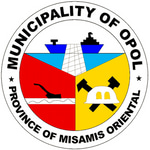Opol Day in the Philippines Date in the current year: June 15, 2026
 Opol Day (Araw ng Opol) is a special non-working holiday celebrated in the Philippine municipality of Opol on June 15 every year. It commemorates the official founding of Opol on this day in 1950.
Opol Day (Araw ng Opol) is a special non-working holiday celebrated in the Philippine municipality of Opol on June 15 every year. It commemorates the official founding of Opol on this day in 1950.Opol is a second-class municipality with a population a little over 66,000 people in the Philippine province of Misamis Oriental. Its name derives from the word opo, which means white gourd. Historically, the white gourd has been one of the most abundant crops in the area. A group of Visayans from Bohol, who settled in the area prior to the arrival of the Spanish, grew the white gourd, and it became so famous that people from the nearby villages came to the area to buy “opo”. At some point the place itself became known as “opo”, which eventually transformed into Opol.
The history of the municipality is intertwined with the history of Cagayan de Oro because Opol used to be its part. During the pre-colonial era, the area was sparsely populated because the local Higaonon people moved from the coastal area to the mountains to limit their contact with Visayans who had arrived from Bohol. However, some remained and maintained contact with Visayans and then with the Spanish. Other settlers in the area included Chinese traders.
The first Spaniards to arrive in Northern Mindanao, a region which included what is now the municipality of Opol, were Augustinian friars in the early 17th century. In the early 19th century, the Spanish colonial authorities created an administrative district (corregimiento) in the region, consisting of four divisions (partidos): Cagayan, Catarman, Dapitan, and Misamis. Opol was part of Partido de Cagayan due to its proximity to what would eventually become the town of Cagayan de Misamis, now known as Cagayan de Oro.
The active economic development of Opol, back then a barrio of Cagayan de Misamis, began at the end of the Spanish colonization, when migrants from Visayas and Luzon, as well as Indians and the Chinese, began to settle in the area in search of new life. Most of these migrants were experienced agricultural workers, and some were wealthy individuals willing to invest in the development of the region. As a result of population growth, it gradually became more and more urbanized.
During World War II, Cagayan de Oro, along with the rest of the Philippines, was occupied by the Empire of Japan. It was one of the towns where the Japanese implemented a scorched-earth policy, destroying everything that would allow Philippine forces to fight back. Nevertheless, guerrilla fighters were active there throughout the entire occupation. The region was liberated in May 1945, and soon the post-war rebuilding of Cagayan de Oro, including the barangays that will eventually form Opol, began.
The town of Opol was formed on June 15, 1950 by splitting the barangays (barrios, neighborhoods) of Opol, Lower Iponan (now Barra) and Igpit from Cagayan de Oro. Today, Opol is subdivided into 14 barangays. Opol’s economy is based on farming, commercial fishing, light industry, and hospitality and tourism.
- Category
- Anniversaries and Memorial Days
- Country
- Philippines
- Tags
- Opol Day in the Philippines, holidays in the Philippines, special non-working holidays, regional observances